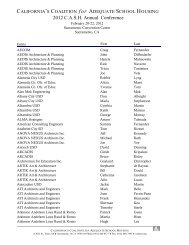Senate Bill 50 and School Facility Fees - California's Coalition for ...
Senate Bill 50 and School Facility Fees - California's Coalition for ...
Senate Bill 50 and School Facility Fees - California's Coalition for ...
Create successful ePaper yourself
Turn your PDF publications into a flip-book with our unique Google optimized e-Paper software.
Section 1<br />
Suspension/Repeal of Mira/Hart/Murrieta<br />
A. The 1986 Legislation. The <strong>School</strong> Facilities Law of 1986 authorized school districts to levy<br />
development fees to fund school facilities. Under this scheme, the maximum amount that could<br />
be levied was $1.<strong>50</strong> per square foot <strong>for</strong> residential development <strong>and</strong> $0.25 per square foot <strong>for</strong><br />
commercial <strong>and</strong> industrial development. (With inflation adjustments, these rates had risen to<br />
$1.93 <strong>and</strong> $0.31 in 1998.) The 1986 law appeared, on its face, to prohibit municipalities to levy<br />
fees in excess of the statutory maximum amounts to fund schools or to deny requests <strong>for</strong><br />
development approvals on the basis of inadequacy of school facilities.<br />
B. Judicial Interpretation. In a series of appellate decisions known as “Mira/Hart/Murrieta",<br />
however, the courts found a way around the limitations of the 1986 law. In Mira Development<br />
Corp. v. City of San Diego ("Mira"), 205 Cal. App. 3d 1201 (1988); William S. Hart Union High<br />
<strong>School</strong> District v. Regional Planning Commission ("Hart"), 226 Cal. App. 3d 1612 (1991); <strong>and</strong><br />
Murrieta Valley Unified <strong>School</strong> District v. County of Riverside ("Murrieta"), 228 Cal. App. 3d<br />
1212 (1991), the courts held that the limitations of the <strong>School</strong> Facilities Law of 1986 only<br />
applied to municipalities when they made adjudicative decisions (such as approvals of parcel<br />
maps, use permits, <strong>and</strong> building permits) but not when they made legislative decisions (such as<br />
general plan amendments, zoning changes, <strong>and</strong> development agreements). The courts held that,<br />
when a municipality made a legislative decision concerning l<strong>and</strong> use, it could consider the<br />
impacts of that decision on school facilities <strong>and</strong> could condition its approval on mitigation<br />
measures, even if the mitigation measures exceeded the limits of what school districts could<br />
require on their own.<br />
Mira/Hart/Murrieta allowed cities <strong>and</strong> counties to use their legislative power over l<strong>and</strong> use (a<br />
part of what is called their "police power") to assist school districts by requiring developer fees,<br />
l<strong>and</strong> dedications, or other measures to fully mitigate the impacts of development on school<br />
facilities. In addition to exercising their police powers to control l<strong>and</strong> development,<br />
municipalities have a duty to assess <strong>and</strong> mitigate the environmental effects of development under<br />
the Cali<strong>for</strong>nia Environmental Quality Act (CEQA) (Public Resources Code Sections 21000 et<br />
seq). Prior to the passage of Proposition 1A, Government Code Section 65996 prohibited local<br />
agencies to deny approval of a "project" on the basis of the adequacy of school facilities. The<br />
Murrieta case interpreted the term "project" to again limit the application of this rule to<br />
adjudicative decisions, thereby allowing mitigation measures under CEQA <strong>for</strong> school facilities<br />
pursuant to legislative acts.<br />
C. Repeal of Mira/Hart/Murrieta. In essence, SB <strong>50</strong> completely relieves cities <strong>and</strong> counties of<br />
the power to require development fees or other exactions in excess of the statutory maximum<br />
amounts to help fund school facilities. SB <strong>50</strong> amends Government Code Section 65995(a) to<br />
provide that only those fees expressly authorized by Education Code Section 17620 (discussed<br />
below) or Government Code Sections 65970 <strong>and</strong> following (the old interim facilities fees) may<br />
be levied or imposed in connection with or made conditions of any legislative or adjudicative act<br />
by a local agency involving planning, use, or development of real property. Subdivision (h) of<br />
section 65995 declares that the payment of the development fees authorized by Education Code<br />
Section 17620 is "full <strong>and</strong> complete mitigation of the impacts of any legislative or adjudicative





